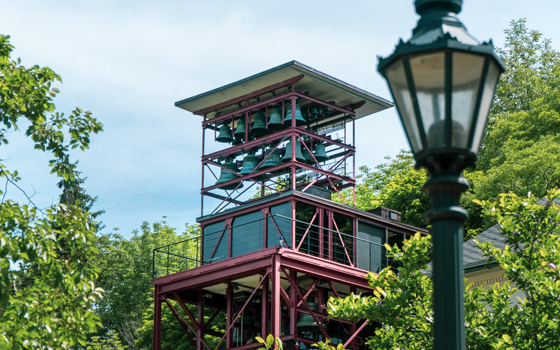
- 201 Eaklor Dr, Alfred, NY 14802 Campus Map
- 607-871-2562
Davis Memorial Carillon
- Theater
The sound of carillon bells has been very much a part of Alfred University for more than seven decades. When classes are in session, the carillon is played four times a week, and during the summer months at least once a week. The Wingate Memorial Summer Carillon Series brings guest recitalists to perform at 7 p.m. each Tuesday in July.
Statistics and History
- Constructed: 1937
- Reconstruction: 1953
- Refurbishment: 1983
About this Facility
Historical sound bites: The original 35 bells arrived in Alfred in 1937 from Antwerp. The train that carried them from New York was greeted by a welcoming committee that included many of the 400-plus alumni and friends whose gifts made the carillon possible. The carillon erected in 1937 was considered a living memorial to Dr. Boothe Colwell Davis, who was Alfred University president from 1895 to 1933, and his wife, Estelle Hoffman Davis. Mrs. Davis died in 1939, and Dr. Davis died in 1942.
The wooden tower that originally contained the carillon bells was replaced in 1953 by an open steel tower, and additional bells were purchased. More bells were added in 1977 to bring the carillon to its current configuration. The open steel tower was enclosed in 1983.
The carillonneur: Laurel Buckwalter is a carillonneur member of the Guild of Carillonneurs of North America, one of a select group of 153 of which only 43 are women.
Buckwalter is the third carillonneur in the University's history. The first was Ray Wingate, who held the position from 1937 to 1968, and the second was Joanne Droppers, who was carillonneur from 1974 to 1994.
A carillon is a musical instrument consisting of at least 23 cast bronze cup-shaped bells which have been precisely tuned so that many bells can be sounded together to produce a harmonious effect. The bells are hung stationary; only the clappers move. The clapper of each bell is connected by wires and other mechanical linkages to a playing console or clavier. The console contains a double row of founded levers called batons, which are arranged in the same pattern as the keys of a piano, plus a pedal board.
To play, the carillonneur sits on a bench facing the console and depresses the batons with her hands, which are loosely clenched into fists. Foot pedals, connected to the heavier bells, are depressed with the feet. As with piano, expressive playing is achieved by a variation of touch. Practice consoles are connected to tuned bronze discs or plates, rather than to the tower bells.
Want more information about the carillon? Call the Performing Arts Office, 607-871-2562.
